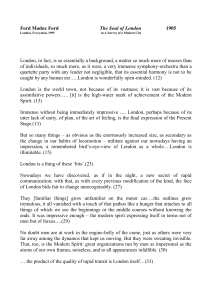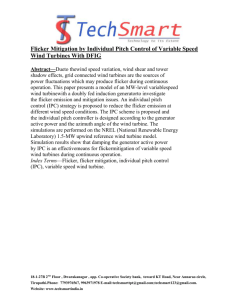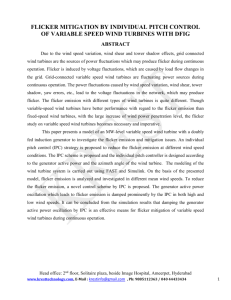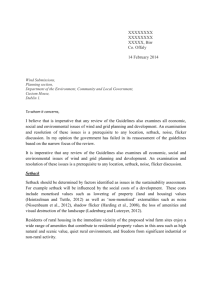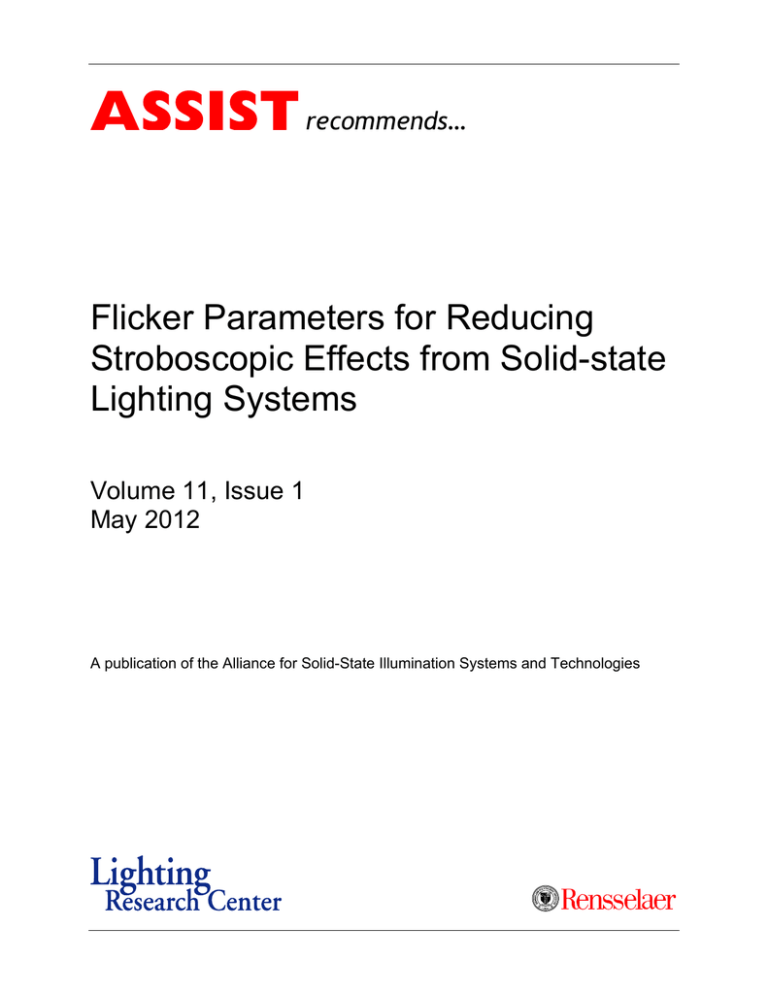
recommends…
Flicker Parameters for Reducing
Stroboscopic Effects from Solid-state
Lighting Systems
Volume 11, Issue 1
May 2012
A publication of the Alliance for Solid-State Illumination Systems and Technologies
recommends…
Copyright © 2012 by the Alliance for Solid-State Illumination Systems and Technologies (ASSIST).
Published by the Lighting Research Center, Rensselaer Polytechnic Institute, 21 Union St., Troy, NY
12180, USA. Online at http://www.lrc.rpi.edu.
All rights reserved. No part of this publication may be reproduced in any form, print, electronic, or
otherwise, without the express permission of the Lighting Research Center.
This publication can be cited in the following manner:
Alliance for Solid-State Illumination Systems and Technologies (ASSIST). 2012. ASSIST
recommends… Flicker Parameters for Reducing Stroboscopic Effects from Solid-state Lighting
Systems. Vol. 11, Iss. 1. Troy, N.Y.: Lighting Research Center. Internet:
http://www.lrc.rpi.edu/programs/solidstate/assist/recommends/flicker.asp.
ASSIST recommends is prepared by the Lighting Research Center (LRC) at the request of the Alliance
for Solid-State Illumination Systems and Technologies (ASSIST). The recommendations set forth here
are developed by consensus of ASSIST members and the LRC. ASSIST and the LRC may update these
recommendations as new research, technologies, and methods become available.
Check for new and updated ASSIST recommends:
http://www.lrc.rpi.edu/programs/solidstate/assist/recommends.asp
ASSIST Members
Acuity Brands Lighting
Lighting Science Group
Amerlux Global Lighting Solutions
Lite-On
Bridgelux
NeoPac Lighting
China Solid State Lighting Alliance
New York State Energy Research and
Development Authority
Cirrus Logic
OSRAM SYLVANIA / OSRAM Opto
Semiconductors
Cooper Industries
Cree
Philips Lighting
Dow Corning
POSCO LED
Federal Aviation Administration
Seoul Semiconductor
GE Lighting Solutions
Sharp Laboratories of America
ITRI, Industrial Technology Research Institute
United States Environmental Protection Agency
Intematix Corp.
WAC Lighting
LG Electronics
WattStopper
LG Innotek
Lighting Research Center Technical Staff
J. D. Bullough, K. Sweater Hickcox, T. Klein, A. Lok, N. Narendran
2
recommends…
Contents
Introduction ................................................................................................................................................... 4
Detection of Stroboscopic Effects ................................................................................................................. 5
Acceptability of Stroboscopic Effects ............................................................................................................ 6
Step 1. Determine the frequency corresponding to the borderline between acceptability and
unacceptability, fb ...................................................................................................................................... 7
Step 2. Estimate the acceptability, a ........................................................................................................ 7
Example Calculations.................................................................................................................................... 8
Application of Calculation Methods ............................................................................................................... 8
Caveats ..................................................................................................................................................... 9
References .................................................................................................................................................. 10
Acknowledgments ....................................................................................................................................... 10
About ASSIST ............................................................................................................................................. 10 3
recommends…
Introduction
Nearly all lighting systems produce flicker, defined in this ASSIST recommends
as the rapid fluctuation of light output in a cyclical manner. For many
conventional lighting technologies (e.g., incandescent, fluorescent, and high
intensity discharge [HID] lamps), flicker is a consequence of 60 Hz (largely in the
Americas) and 50 Hz (in Europe, Asia, Africa and Australia) alternating current
(AC) power line frequencies. Alternating polarity at these frequencies can result
in flicker at twice the power line frequency (e.g., 120 Hz or 100 Hz), if electronic
ballast circuitry is not employed. The thermal mass of incandescent filaments and
decay characteristics of phosphors can reduce the flicker amplitude. This
amplitude can be characterized in different ways (Rea 2000), the most commonly
used of which are percent flicker and flicker index. Percent flicker is defined in
terms of the difference between the minimum and maximum light output during a
flicker waveform cycle:
Percent flicker = [(maximum – minimum)/(maximum + minimum)] 100%
Figure 1 illustrates two rectangular waveforms showing the temporal modulation
of light output as a function of time. The waveform in Figure 1a shows 100%
flicker at 300 Hz, while the waveform in Figure 1b shows 33% flicker at 120 Hz.
relative light output (arb. units)
1
0.8
0.6
0.4
0.2
0
0
10
20
30
40
50
40
50
time (ms)
a.
relative light output (arb. units)
1
0.8
0.6
0.4
0.2
0
0
10
20
30
time (ms)
b.
Figure 1. a) Flicker waveform showing 100% flicker at a frequency of 300 Hz;
b) flicker waveform showing 33% flicker at a frequency of 120 Hz.
4
recommends…
If a light source ever produces no light during any portion of the cycle (as in
Figure 1a), the percent flicker is 100%. Flicker index (Eastman and Campbell
1952) is defined with respect to a plot of the light output curve as a function of
time (Rea 2000). Flicker index is the area under the light output curve and above
the time-averaged light output for the entire cycle, divided by the total area under
the light output curve. For a given waveform shape and duty cycle (duty cycle is
defined here as the percentage of time during a flicker cycle that the light output
exceeds 10% of the maximum value), percent flicker and flicker index are
proportional to each other.
Direct visual perception of flicker is negligible at frequencies of 100 Hz or higher
(Kelly 1961, De Lange 1958, Bullough et al. 2011). However, indirect perception
of flicker is possible through stroboscopic effects at frequencies of 100–120 Hz
(Rea and Ouellette 1988) and widespread perception of stroboscopic effects has
been reported at 500 Hz (Hershberger et al. 1998). The variety of methods by
which light-emitting diodes (LEDs) can be driven means that various flicker
frequencies and percent flicker values could be possible in lighting systems using
these sources. Perception of stroboscopic effects decreases as frequency
increases (Hershberger et al. 1998, Bullough et al. 2011) and as percent flicker
(or flicker index) decreases (Rea and Ouellette 1988). This ASSIST recommends
document outlines a preliminary method for trading off these two factors based
on recent data (Bullough et al. in press). This method does not include non-visual
effects of flicker such as eyestrain or headaches (IEEE 2010).
Detection of Stroboscopic Effects
For rectangular waveforms operated so that the maximum light output is
produced 50% of the time and the minimum light output is produced 50% of the
time, the percent likelihood of detection (d, in percent) of stroboscopic effects can
be estimated in terms of the frequency (f, in Hz) and percent flicker (p, in percent)
as follows (Bullough et al. in press):
d = [(25p + 140)/(f + 25p + 140)] 100%
The detection data from the study by Bullough et al. (in press) are shown in the
contour plot in Figure 2, as a function of flicker frequency and percent flicker.
Also shown in Figure 2 are the frequency and percent flicker values for several
common light sources.
This equation is applicable to frequencies from 100 to 10,000 Hz and for percent
flicker values from 5% to 100%. The visual task used to assess stroboscopic
effects was waving a light-colored rod against a dark background (Bullough et al.
in press), and represents close to a worst-case scenario for detection of
stroboscopic effects.
5
recommends…
Figure 2. Mean measured detection percentages for stroboscopic effects by light
sources varying in flicker frequency and percent flicker (Bullough et al. in press).
Also shown are the locations of several common light sources in terms of flicker
frequency and percent flicker (HPS: 250 W high pressure sodium lamp; MH: 250 W
metal halide lamp; WWF: 40 W warm-white halophosphor fluorescent lamp; INC:
100 W incandescent lamp).
Acceptability of Stroboscopic Effects
To assess acceptability of flicker producing noticeable stroboscopic effects, a
five-point scale was used by Bullough et al. (in press):
+2
+1
0
–1
–2
very acceptable
somewhat acceptable
neither acceptable nor unacceptable
somewhat unacceptable
very unacceptable
The acceptability data from the study by Bullough et al. (in press) are shown in
the contour plot in Figure 3, as a function of flicker frequency and percent flicker.
Also shown in Figure 3 are the frequency and percent flicker values for several
common light sources. None of the mean acceptability ratings were below –1.
The data in Figures 2 and 3 suggest that even when stroboscopic effects from
flicker were readily detected, they were not always judged as unacceptable. For
example, at 1000 Hz, detection of stroboscopic effects (Figure 2) was highly
dependent upon the amount of modulation (percent flicker), but ratings of
acceptability (Figure 3) were relatively high regardless of the percent flicker
value.
6
recommends…
Figure 3. Mean measured acceptability ratings for stroboscopic effects by light
sources varying in flicker frequency and percent flicker (Bullough et al. in press).
Also shown are the locations of several common light sources in terms of flicker
frequency and percent flicker (HPS: 250 W high pressure sodium lamp; MH: 250 W
metal halide lamp; WWF: 40 W warm-white halophosphor fluorescent lamp; INC:
100 W incandescent lamp).
For rectangular waveforms operated so that the maximum and minimum light
output are produced 50% of the time, the predicted acceptability (a, using the
scale above) of noticeable stroboscopic effects can be quantified in terms of the
frequency (f, in Hz) and percent flicker (p, in percent) as follows (Bullough et al.
in press):
Step 1. Determine the frequency corresponding to the borderline
between acceptability and unacceptability, fb
For a given percent flicker value (p, in percent), the frequency at which a rating of
zero, corresponding to the borderline between acceptability and unacceptability
of stroboscopic effects (fb, in Hz), is calculated as follows:
fb = 130 log p – 73
Step 2. Estimate the acceptability, a
For a given flicker frequency (f, in Hz), and using the borderline frequency (fb, in
Hz) calculated in Step 1, the resulting acceptability (a, based on the scale above)
can be estimated as follows:
a = 2 – 4/(1 + f/fb)
This equation is applicable to frequencies from 100 to 10,000 Hz and for percent
flicker values from 5% to 100%. The visual task used to assess stroboscopic
effects was waving a light-colored rod against a dark background (Bullough et al.
7
recommends…
in press), and represents close to a worst-case scenario for perception of
stroboscopic effects.
Example Calculations
Suppose a light source produces a rectangular waveform with the maximum and
minimum light output each produced 50% of the time, with a frequency (f) of 350
Hz and percent flicker (p) value of 50%. To estimate the percent likelihood of
detecting stroboscopic effects (d) under conditions similar to those used by
Bullough et al. (in press), the following calculation is performed:
(25 50 + 140)/(350 + 25 50 + 140) 100% = 80%
Thus, under conditions similar to waving a light-colored rod against a dark
background, the light source would be expected to produce noticeable
stroboscopic effects 80% of the time.
For 50% flicker, the frequency at the borderline between acceptability and
unacceptability (fb) is calculated as follows:
130 log 50 – 73 = 148 Hz
Using a value for fb of 148 Hz, the estimated acceptability rating for this condition
is:
2 – 4/(1 + 350/148) = +0.81
Thus, under conditions similar to waving a light-colored rod against a dark
background, the light source would be expected to elicit an average acceptability
rating of +0.81, corresponding approximately to somewhat acceptable.
Application of Calculation Methods
Because the study that assessed stroboscopic effects (Bullough et al. in press)
used a light-colored, rapidly moving object viewed against a dark background, it
comprises a near-worst-case condition for perception of stroboscopic effects.
Slower movements, objects with lower contrast, and the presence of nonflickering light sources such as daylight would all be expected to reduce the
likelihood of detecting, and to increase the acceptability of, stroboscopic effects
from a flickering light source.
For this reason, a relative criterion for reducing the perception of stroboscopic
effects is proposed. Further, a specification criterion based on the detection of
stroboscopic effects rather than on acceptability is proposed, because this is
likely to result in a more conservative specification. Reducing the detectability of
stroboscopic effects is also likely to increase their acceptability, but not vice
versa, based on the data in Figures 2 and 3.
Few people consider incandescent lamps to be problematic light sources in
terms of flicker or stroboscopic effects, although these sources produce flicker
that can result in noticeable stroboscopic effects. A 60 W incandescent lamp,
when operated on a 60 Hz AC power supply, produces 8% flicker (Rea 2000).
Using data from Rea (2000) and interpolating for a 50 Hz AC power supply, it is
8
recommends…
estimated that the same lamp would produce 10% flicker. If one desired to limit
the detection of stroboscopic effects from an arbitrary light source to be no
greater than under a 60 W incandescent lamp operated on 50 Hz AC power, the
equation provided in the section above entitled “Detection of Stroboscopic
Effects” could be rearranged to solve for the maximum percent flicker value (pmax)
for a given frequency (f) that would result in stroboscopic effects no greater than
those from a 60 W incandescent lamp, as follows:
pmax = 0.16f – 5.6
For example, if a particular driving circuit results in an LED source producing a
flicker frequency of 120 Hz, the equation above would predict that the percent
flicker value could be up to 14% and the source would not produce stroboscopic
effects more perceptible than those from a 60 W incandescent lamp operated on
50 Hz AC power. If the flicker frequency were 250 Hz, the percent flicker value
could be up to 34%.
For flicker frequencies higher than 660 Hz, the equation above will yield percent
flicker values greater than 100%. This implies that for any frequency higher than
this value, any amount of flicker will be less noticeable than that from the
incandescent reference condition.
Caveats
As described above, the data underlying the equation in the previous section
correspond to the perception of stroboscopic effects from a light source
producing a rectangular waveform with the maximum and minimum light output
each produced 50% of the time, and for a visual stimulus consisting of a lightcolored rod being waved against a dark background, for frequencies between
100 and 10,000 Hz, and for percent flicker values between 5% and 100%. They
are also only applicable when the flickering source is the only light source in a
space. The presence of daylight from windows or other light sources with
different flicker characteristics will reduce the perception of stroboscopic effects.
9
recommends…
References
Bullough, J.D., K. Sweater Hickcox, T.R. Klein, and N. Narendran. 2011. Effects
of flicker characteristics from solid-state lighting on detection,
acceptability and comfort. Lighting Research and Technology 43(3):
337–348.
Bullough, J.D., K. Sweater Hickcox, T.R. Klein, A. Lok, and N. Narendran. [In
press.] Detection and acceptability of stroboscopic effects from flicker.
Lighting Research and Technology, doi: 10.1177/1477153511414838.
De Lange, H. 1958. Research into the dynamic nature of the human fovea-cortex
systems with intermittent and modulated light: I. Attenuation
characteristics with white and colored light. Journal of the Optical Society
of America 48: 777–784.
Eastman, A.A., and J.H. Campbell. 1952. Stroboscopic and flicker effects from
fluorescent lamps. Illuminating Engineering 47: 27–35.
Hershberger, W.A., S.S. Jordan, and D.R. Lucas. 1998. Visualizing the
perisaccadic shift of spatiotopic coordinates. Perception and
Psychophysics 60: 82–88.
Institute of Electrical and Electronics Engineers. 2010. A Review of the Literature
on Light Flicker: Ergonomics, Biological Attributes, Potential Health
Effects, and Methods in Which Some LED Lighting May Introduce
Flicker, IEEE P1789 [draft]. New York: Institute of Electrical and
Electronics Engineers.
Kelly, D.H. 1961. Visual responses to time-dependent stimuli: I. Amplitude
sensitivity measurements. Journal of the Optical Society of America 51:
422–429.
Rea, M.S. (editor). 2000. IESNA Lighting Handbook: Reference and Application,
9th edition. New York: Illuminating Engineering Society.
Rea, M.S., and M.J. Ouellette. 1988. Table-tennis under high intensity discharge
lighting. Journal of the Illuminating Engineering Society 17: 29–35.
Acknowledgments
ASSIST and the Lighting Research Center would like to thank the following for
their review and participation in the development of this publication: J.P.
Freyssinier, H. Ohlhous, M. Overington, and N. Skinner.
About ASSIST
ASSIST was established in 2002 by the Lighting Research Center at Rensselaer
Polytechnic Institute as a collaboration among researchers, manufacturers, and
government organizations. ASSIST’s mission is to enable the broad adoption of
solid-state lighting by providing factual information based on applied research
and by visualizing future applications.
10


